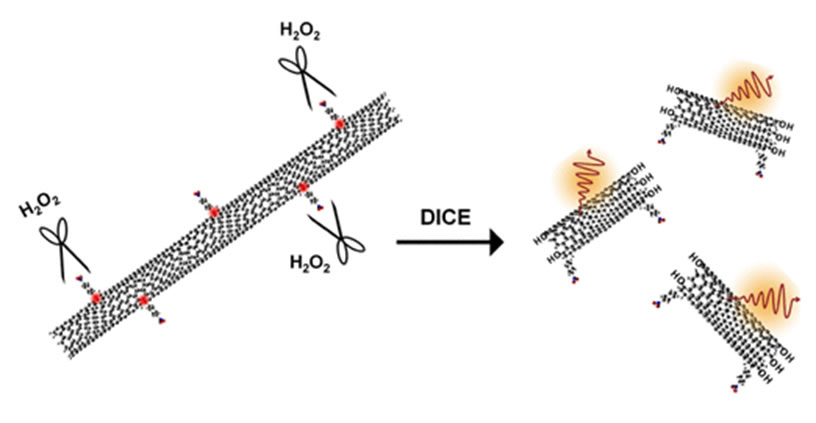Fluorescent Ultrashort Nanotubes from Defect-Induced Chemical Cutting

Chemistry of Materials 2019, 31, 4536-4544
Yunfeng Li, Xiaojian Wu, Mijin Kim, Jacob Fortner, Haoran Qu, and YuHuang Wang
The abstract reads as follows: Ultrashort single-walled carbon nanotubes (SWCNTs) that fluoresce brightly in the shortwave infrared could open exciting opportunities in high-resolution bioimaging and sensing. However, this material remains largely unexplored due to the synthetic challenge. Here, we describe a high-yield synthesis of fluorescent ultrashort nanotubes based on a fundamentally new understanding of defect-induced chemical etching of SWCNTs. We first implant fluorescent sp3 quantum defects along the nanotube sidewalls and then oxidatively cut the nanotubes into ultrashort pieces using hydrogen peroxide. This simple two-step process leads to the synthesis of fluorescent ultrashort nanotubes with a narrow length distribution (38 ± 18 nm) and a yield as high as 57%. Despite their ultrashort length, the cut SWCNTs fluoresce brightly in the shortwave infrared at wavelengths characteristic of the sp3 defects, which provides a spectral fingerprint allowing us to uncover new insights into this defect-induced cutting process. Quantum chemical computations suggest that this etching reaction occurs selectively at the defect sites where hydroxyl radicals (•OH) attack the surrounding electron-rich carbon atoms. This work reveals fundamental insights into defect chemistry and makes fluorescent ultrashort nanotubes synthetically accessible for both basic and applied studies of this largely unexplored but rich class of synthetic molecular nanostructures.
Y.L. and X.W. are partially supported by the Center for Enhanced Nanofluidic Transport (CENT), an Energy Frontier Research Center funded by the U.S. Department of Energy, Office of Science, Basic Energy Sciences under Award # DE-SC0019112 to apply FUNs as a model system for fundamental studies of nanofluidic transport.
